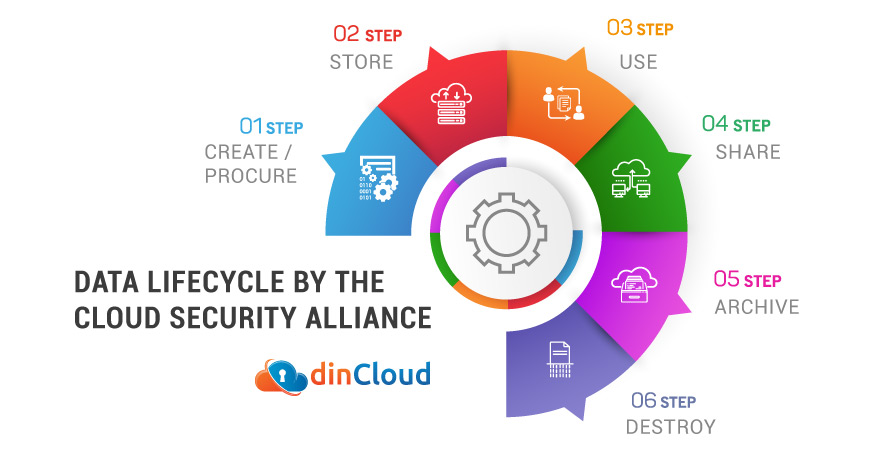Today, we live in a highly data driven world. The ability of enterprises to seek relevant data and convert the same into actionable business insights can result in a major competitive edge. However, data brings along a host of challenges that need to be addressed.

Data Lifecycle Management (DLM)
The challenges around managing data can be greatly mitigated if your enterprise can successfully correlate the same with a lifecycle. After all, the data you either generate or procure has a certain lifespan, after which it tends to lose its efficacy.
So, if you can successfully map the entire lifecycle of your enterprise data, you will not only be in a much better position to manage it, but also be in a commanding position to leverage this data to your maximum benefit.
Related: 10 Benefits of Desktop-as-a-Service (DaaS) You Don’t Want to Miss
DLM from a Security Standpoint
The data that enterprises use is not only of business value, but each class of data that an enterprise utilizes must also adhere to the industry’s prescribed security standards. So, security is of paramount importance when defining the parameters of DLM.
A security centric approach towards data lifecycle management (DLM) will elevate the level of trust your customers and key stakeholders place in you. This is also important in the context of meeting the ever increasing data related regulatory standards.
Data Lifecycle by the Cloud Security Alliance (CSA)
The data lifecycle of each enterprise will vary, based on its unique needs and prevalent regulatory standards. However, the Cloud Security Alliance (CSA) has outlined a generic lifecycle for cloud data, which is a great starting point for enterprises.
In this post, we will briefly touch upon the six stages of the cloud data lifecycle, and how each enterprise can use this blueprint to its fullest advantage.
Related: DATA LIFECYCLE Management in Cloud Environments
Create / Procure
This first stage of the cloud data lifecycle could vary between creation and procurement of data. Some enterprises rely on internal sources for generating data, while others tend to procure the same from industry experts and extract business insights from it.
At this stage, you will have to take into account the security and compliance related credentials of your public Cloud Service Provider (CSP). The data centers of dinCloud, for instance, meet some of the industry’s best standards for security and privacy.
Store
This stage of the data lifecycle will entail questions as to where each class of data would preferably be stored. It can entirely be in the public cloud, or an enterprise may choose to retain some data on premise, while store the rest over public cloud data centers.
Use
What good is data if you cannot leverage the same to extract business value? So, how well you can use this data is a key differentiating factor. Over the public cloud, you have access to nearly limitless processing resources to play around with all this data.
The end goal is to improve existing products and services, while also identifying any new avenues that can be tapped. How well an enterprise uses its data will play a key role in determining whether you become an industry leader or just a trend follower.
Share
This is yet another critical step of the data lifecycle, where the public cloud clearly stands out. Over the cloud, sharing enterprise data with employees and other key stakeholders is a breeze. Over the cloud, you enjoy centralization of data, which is an advantage in itself.
However, one important aspect to keep in mind here is that the least privileged access approach serves the best. In such an approach to cloud data security, you give employees access to enterprise data over the cloud purely on a need basis.
Archive
This is perhaps one of the most important, and even controversial stages of data lifecycle management. This is when you decide which classes of data are still relevant, and also the data whose further retention will cost more to the enterprise than its benefits.
At this stage, you can also define the efficient “timelines” for each individual class of enterprise data. By adhering to these timelines, you will be able to achieve cost optimization, as storing data on premise or over the cloud carries a cost.
Destroy
The sixth, and last key step in the data lifecycle management is that of destroying the data that is no more required, or it is of no value to the enterprise anymore. Any data which does not qualify for archiving anymore requires destruction.
However, this is also a key step, as you will have to follow the prescribed best practices for destruction of data. Any data which is not properly destroyed could potentially end up in the wrong hands and cause more harm than good.
Conclusion
The data lifecycle outlined by the Cloud Security Alliance (CSA) is a great starting point. From here on end, each enterprise will have to adopt a cloud data lifecycle that best suits its existing and future needs.
Contact dinCloud for your data related needs over the cloud, as we have both the management and security credentials to fulfill your enterprise needs.


